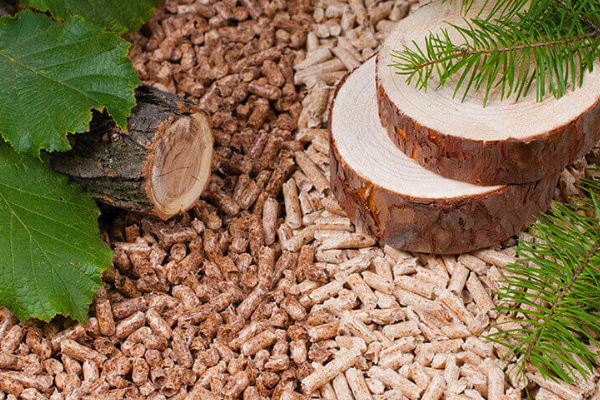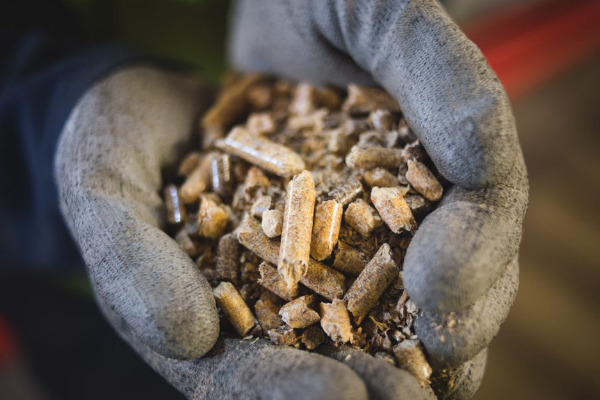Made of hardwood (such as oak, maple, etc.), the pellets have high density and long burning time.
High calorific value, suitable for scenes requiring long-term stable heating, especially for cold climates. The high density and low moisture content of hardwood pellets make it burn for a long time, reducing the trouble of frequent fuel addition. Although the price is higher, it is an ideal choice for users who need efficient heating.
Suitable for scenes requiring long-term stable heating, long burning time and stable heat output.
The high density and low moisture content of hardwood pellets make it burn for a long time, reducing the trouble of frequent fuel addition. Its high calorific value and low carbon deposition help extend the service life of the heater. Although the price is higher, it is an ideal choice in cold climates or when efficient heating is needed.

4. Cork wood pellets
Introduction
Made of cork (such as pine, fir, etc.), it has a low density and a relatively short burning time.
Features
Cheap, low calorific value, suitable for homes in warm climates or with low heating needs. However, the combustion calorific value of cork wood pellets is low, frequent fuel addition is required, and more ash is produced after combustion, which may increase the frequency of cleaning the heater.
Application Effect
Suitable for homes in warm climates or with low heating needs, with a short burning time.
Cork pellets are cheap, but have a low calorific value, and more ash is produced after combustion, which may increase the frequency of cleaning the heater. Suitable for areas with warm climates or low heating needs, users need to weigh economic efficiency and maintenance costs.

5. Industrial wood pellets
Introduction
Mainly used in industrial boilers or power stations, containing more impurities and ash.
Features
Suitable for large-scale combustion needs, such as industrial boilers or power stations, low cost, but not suitable for home use. Due to the large amount of impurities, a large amount of ash will be produced during the combustion process, which is easy to cause the heater to be blocked and difficult to maintain.
Application Effect
Mainly used in large industrial boilers or power stations, not suitable for home heaters.
Industrial-grade wood pellets contain a large amount of impurities and ash, and a large amount of ash will be produced during combustion, which is easy to cause the heater to be blocked and difficult to maintain. Suitable for large-scale industrial applications, not suitable for home heating needs.
Professional advice on choosing wood pellets
When choosing wood pellets, users should consider fuel costs, equipment compatibility, maintenance requirements, and environmental protection requirements:
1. Give priority to pure wood pellets or hardwood pellets: they can provide higher combustion efficiency and less ash, ensuring the stability and environmental protection of heating. Although the price is higher, its performance advantages are more prominent under the demand for efficient heating.
2. Pay attention to the calorific value and ash content of the fuel: choosing high calorific value pellets can provide more heat output, and low ash pellets can reduce the frequency of equipment cleaning and extend the service life of the equipment.
3. Balance between economy and environmental protection: Although mixed wood pellets and softwood pellets are more advantageous in price, they may require more frequent maintenance and cleaning. Users should make a balanced choice based on their actual situation to maximize economic benefits and ease of use.
4. Consider the source and stability of the pellets: choosing wood pellets with stable sources and reliable quality can ensure the continuous satisfaction of long-term heating needs and ensure the efficient operation of the heater.
As a clean and renewable fuel, wood pellets have broad application prospects in pellet heaters. However, different types of wood pellets have different effects on heaters. For home or commercial heating, it is recommended to give priority to pure wood pellets or hardwood pellets, which can not only ensure efficient heating, but also extend the service life of heating equipment. Choosing the right wood pellets will greatly improve your heating experience. In addition, when choosing wood pellets, you should ensure that they meet relevant quality standards, such as ENplus or DINplus certification, to ensure clean and environmentally friendly combustion.
English
Español
العربية
Français
Русский
Português
Deutsch
italiano
Nederlands
Polski
Türkçe
日本語
한국어
ဗမာစာ
தமிழ்
Bahasa Indonesia
Čeština
қазақ
Српски
فارسی
Slovenčina
Slovenščina
Norsk
Svenska
Ελληνικά
Suomi
Latine
Dansk
Shqip
বাংলা
Hrvatski
Gaeilge
Eesti keel
සිංහල
नेपाली
Oʻzbekcha
latviešu
Български
ქართული
ગુજરાતી
íslenska
ಕನ್ನಡ
Lietuvių
Lëtzebuergesch
മലയാളം
Malti
मराठी
ଓଡ଼ିଆ
پښتو
ਪੰਜਾਬੀ
తెలుగు
isiZulu





















